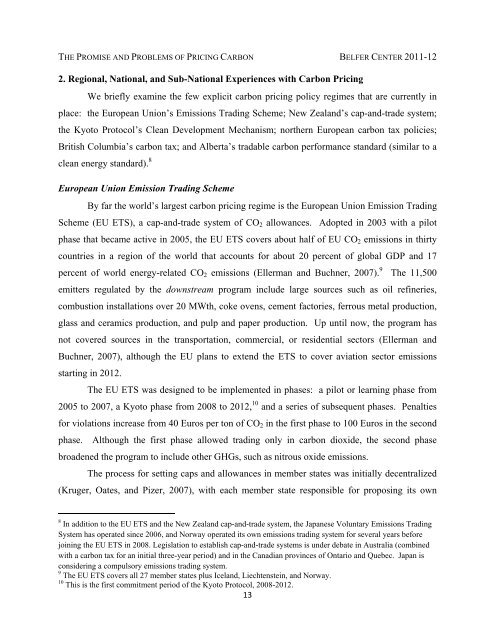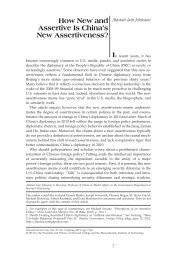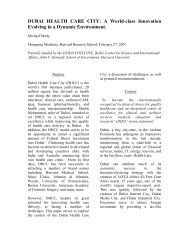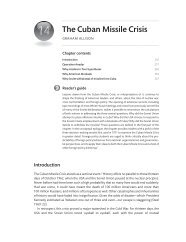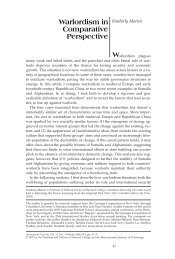The Promise and Problems of Pricing Carbon: - Belfer Center for ...
The Promise and Problems of Pricing Carbon: - Belfer Center for ...
The Promise and Problems of Pricing Carbon: - Belfer Center for ...
Create successful ePaper yourself
Turn your PDF publications into a flip-book with our unique Google optimized e-Paper software.
THE PROMISE AND PROBLEMS OF PRICING CARBON BELFER CENTER 2011-12<br />
2. Regional, National, <strong>and</strong> Sub-National Experiences with <strong>Carbon</strong> <strong>Pricing</strong><br />
We briefly examine the few explicit carbon pricing policy regimes that are currently in<br />
place: the European Union’s Emissions Trading Scheme; New Zeal<strong>and</strong>’s cap-<strong>and</strong>-trade system;<br />
the Kyoto Protocol’s Clean Development Mechanism; northern European carbon tax policies;<br />
British Columbia’s carbon tax; <strong>and</strong> Alberta’s tradable carbon per<strong>for</strong>mance st<strong>and</strong>ard (similar to a<br />
clean energy st<strong>and</strong>ard). 8<br />
European Union Emission Trading Scheme<br />
By far the world’s largest carbon pricing regime is the European Union Emission Trading<br />
Scheme (EU ETS), a cap-<strong>and</strong>-trade system <strong>of</strong> CO2 allowances. Adopted in 2003 with a pilot<br />
phase that became active in 2005, the EU ETS covers about half <strong>of</strong> EU CO2 emissions in thirty<br />
countries in a region <strong>of</strong> the world that accounts <strong>for</strong> about 20 percent <strong>of</strong> global GDP <strong>and</strong> 17<br />
percent <strong>of</strong> world energy-related CO2 emissions (Ellerman <strong>and</strong> Buchner, 2007). 9 <strong>The</strong> 11,500<br />
emitters regulated by the downstream program include large sources such as oil refineries,<br />
combustion installations over 20 MWth, coke ovens, cement factories, ferrous metal production,<br />
glass <strong>and</strong> ceramics production, <strong>and</strong> pulp <strong>and</strong> paper production. Up until now, the program has<br />
not covered sources in the transportation, commercial, or residential sectors (Ellerman <strong>and</strong><br />
Buchner, 2007), although the EU plans to extend the ETS to cover aviation sector emissions<br />
starting in 2012.<br />
<strong>The</strong> EU ETS was designed to be implemented in phases: a pilot or learning phase from<br />
2005 to 2007, a Kyoto phase from 2008 to 2012, 10 <strong>and</strong> a series <strong>of</strong> subsequent phases. Penalties<br />
<strong>for</strong> violations increase from 40 Euros per ton <strong>of</strong> CO2 in the first phase to 100 Euros in the second<br />
phase. Although the first phase allowed trading only in carbon dioxide, the second phase<br />
broadened the program to include other GHGs, such as nitrous oxide emissions.<br />
<strong>The</strong> process <strong>for</strong> setting caps <strong>and</strong> allowances in member states was initially decentralized<br />
(Kruger, Oates, <strong>and</strong> Pizer, 2007), with each member state responsible <strong>for</strong> proposing its own<br />
8<br />
In addition to the EU ETS <strong>and</strong> the New Zeal<strong>and</strong> cap-<strong>and</strong>-trade system, the Japanese Voluntary Emissions Trading<br />
System has operated since 2006, <strong>and</strong> Norway operated its own emissions trading system <strong>for</strong> several years be<strong>for</strong>e<br />
joining the EU ETS in 2008. Legislation to establish cap-<strong>and</strong>-trade systems is under debate in Australia (combined<br />
with a carbon tax <strong>for</strong> an initial three-year period) <strong>and</strong> in the Canadian provinces <strong>of</strong> Ontario <strong>and</strong> Quebec. Japan is<br />
considering a compulsory emissions trading system.<br />
9<br />
<strong>The</strong> EU ETS covers all 27 member states plus Icel<strong>and</strong>, Liechtenstein, <strong>and</strong> Norway.<br />
10<br />
This is the first commitment period <strong>of</strong> the Kyoto Protocol, 2008-2012.<br />
13


